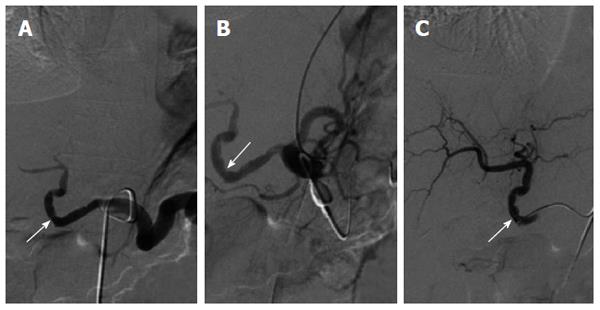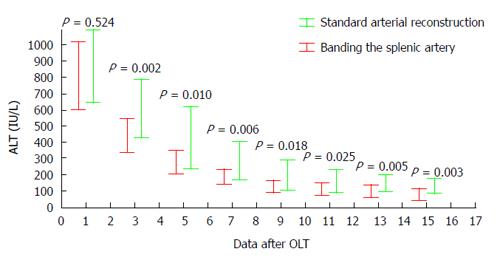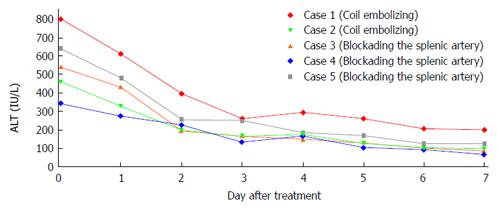Copyright
©2014 Baishideng Publishing Group Inc.
World J Gastroenterol. Nov 7, 2014; 20(41): 15367-15373
Published online Nov 7, 2014. doi: 10.3748/wjg.v20.i41.15367
Published online Nov 7, 2014. doi: 10.3748/wjg.v20.i41.15367
Figure 1 Doppler images during occluding the splenic artery.
A: Normal portal vein and disappeared hepatic artery flow signal as revealed by Doppler ultrasonography on the 2nd day after transplantation; B: Reappearance of the hepatic artery flow signal revealed by Doppler ultrasonography after the treatment by occluding the splenic artery temporarily; C: Better hepatic artery flow signal on the 5th day after the treatment; D: Normal hepatic artery flow signal at the end of the 3th month after the orthotopic liver transplantation.
Figure 2 Radiological images during occluding the splenic artery (arrow is the anastomotic site).
A: Selective celiac trunk arteriogram shows reduced hepatic artery perfusion and enlarged splenic artery perfusion; B: Increased hepatic arterial perfusion was seen after occluding the splenic artery temporarily; C: Normal hepatic arterial flow was reestablished 5 d after the treatment.
Figure 3 Fluctuation of mean alanine transarninase in the recipients in the two groups after the treatments.
The alanine transarninase (ALT) in the patients who underwent banding the splenic artery decreased faster than that in the patients in the control group. OLT: Orthotopic liver transplantation.
Figure 4 Fluctuation of alanine transarninase in the patients with splenic artery steal syndrome after the treatments.
ALT: Alanine transarninase.
- Citation: Song JY, Shi BY, Zhu ZD, Zheng DH, Li G, Feng LK, Zhou L, Wu TT, Du GS. New strategies for prevention and treatment of splenic artery steal syndrome after liver transplantation. World J Gastroenterol 2014; 20(41): 15367-15373
- URL: https://www.wjgnet.com/1007-9327/full/v20/i41/15367.htm
- DOI: https://dx.doi.org/10.3748/wjg.v20.i41.15367












